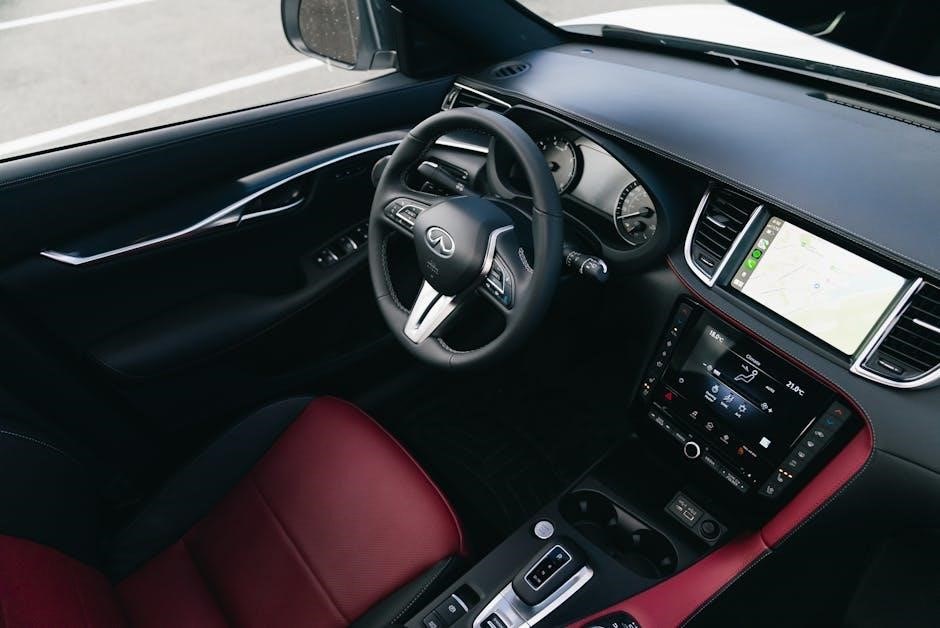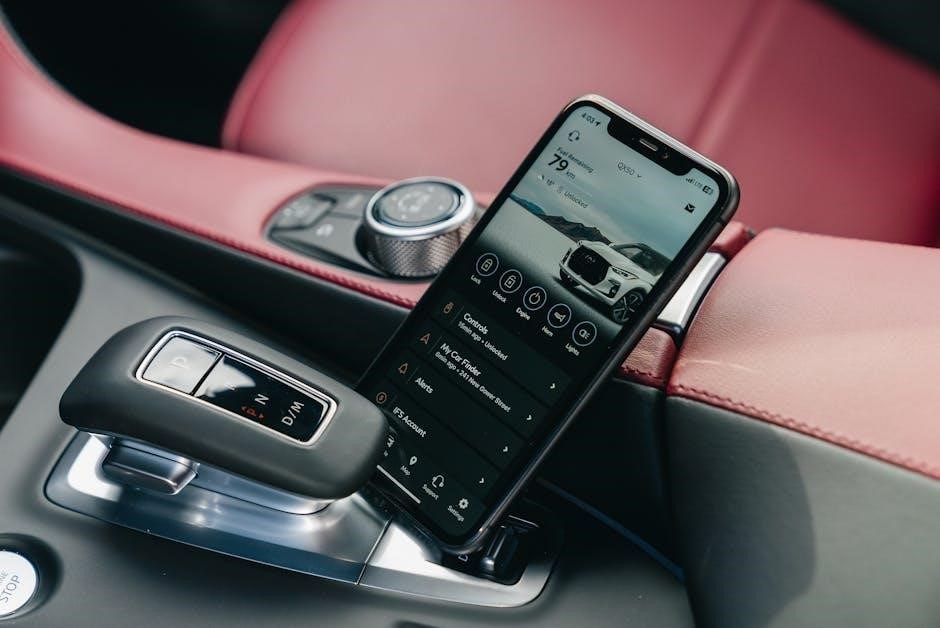This manual introduces the Bushnell BackTrack GPS, a compact navigation tool designed for outdoor enthusiasts. It provides essential guidance for setup, operation, and troubleshooting to ensure effective use in various outdoor activities like hiking, hunting, and wilderness exploration. The device offers features such as waypoint marking, digital compass, and GPS tracking, making it a reliable companion for navigating remote areas. Understanding the manual is crucial for maximizing the device’s performance and ensuring safe, accurate navigation.
1.1 Overview of the Bushnell BackTrack GPS Device
The Bushnell BackTrack GPS is a compact, portable navigation tool designed for outdoor enthusiasts. It features a digital compass, waypoint marking, and SiRF Star III GPS technology for accurate location tracking. Ideal for hiking, hunting, and wilderness exploration, the device stores up to three locations, providing direction and distance back to each waypoint. Its lightweight and user-friendly design makes it a reliable companion for adventurers seeking to navigate remote areas with confidence. The BackTrack GPS ensures users can mark and return to essential points, such as campsites, vehicles, or trails, enhancing safety and convenience in the great outdoors.
1.2 Importance of the Manual for Effective Use
The manual is essential for unlocking the full potential of the Bushnell BackTrack GPS. It provides detailed instructions on operating the device, understanding its features, and troubleshooting common issues. Without the manual, users may struggle to navigate the interface or utilize advanced functions like waypoint marking and route recording. The guide also offers tips for optimizing battery life and ensuring accurate GPS performance. By following the manual, users can maximize the device’s functionality, enhance their outdoor experiences, and avoid potential frustrations. It serves as a comprehensive resource for both beginners and experienced users to get the most out of their BackTrack GPS.

Key Features of the Bushnell BackTrack GPS
The Bushnell BackTrack GPS is compact and lightweight, designed for easy carrying. It includes a digital compass for navigation and allows storing important locations. With reliable GPS technology, it provides precise tracking in remote areas, featuring a user-friendly interface for simple operation in various outdoor conditions.
2.1 Compact and Portable Design
The Bushnell BackTrack GPS boasts a lightweight and ergonomic design, making it easy to carry on hikes or hunts. Its small size allows it to fit in a pocket or attach to a belt. The device is built to withstand rough conditions, with a durable exterior that resists water and dust. A built-in lanyard loop or carabiner compatibility adds convenience for securing it to gear. The portable nature ensures it’s always ready for adventure, while its user-friendly interface simplifies navigation. This design makes it an ideal companion for outdoor enthusiasts seeking a reliable, space-saving GPS solution.
2.2 Digital Compass and GPS Navigation
The Bushnell BackTrack GPS features a built-in digital compass that provides precise directional readings, essential for accurate navigation. Combined with its GPS capabilities, the device offers real-time location tracking and route mapping; The digital compass helps users determine their bearings, while the GPS ensures precise positioning. This combination is ideal for outdoor activities like hiking or hunting, where knowing direction and location is critical. The GPS navigation system supports multiple satellites for enhanced accuracy, while the compass adjusts for magnetic variations. Together, these features ensure reliable performance in various environments, helping users stay on course and reach their destinations efficiently.
2.3 Waypoint Marking and Storage
The Bushnell BackTrack GPS allows users to mark and store waypoints with ease, enabling quick navigation to important locations. This feature is particularly useful for tracking routes, campsites, or hunting stands. Users can store up to 25 waypoints, each marked with a unique identifier and coordinates. The device also provides the option to label waypoints for easier reference. Stored locations can be retrieved later, ensuring users can retrace their path or return to specific spots effortlessly. This functionality enhances navigation accuracy and simplifies exploring unfamiliar territories, making it a valuable tool for outdoor enthusiasts.
2.4 SiRF Star III GPS Technology
The Bushnell BackTrack GPS incorporates the SiRF Star III GPS Technology, known for its high sensitivity and ability to maintain a strong signal even in challenging environments. This advanced technology enables rapid satellite acquisition and reliable performance in areas with heavy tree cover, deep canyons, or urban settings. The SiRF Star III ensures accurate location tracking and consistent navigation, making it ideal for outdoor activities such as hiking, hunting, or geocaching. Its enhanced signal strength and fast processing capabilities contribute to the device’s overall performance, providing users with a dependable GPS experience in various conditions.

Setting Up the Bushnell BackTrack GPS
Start by inserting AAA batteries into the battery compartment. Turn on the device using the power button. Follow the on-screen prompts to select your language and units. Go outside to an open area to acquire a GPS signal, ensuring the device locks onto satellites. Familiarize yourself with the interface, exploring buttons for waypoint marking and navigation. Test the device by marking a waypoint and verifying location accuracy. Ensure all features function correctly before first use.
3.1 Initial Power-On and Setup
Insert the AAA batteries into the battery compartment, ensuring they are securely fitted. Press and hold the power button until the device turns on. The Bushnell BackTrack GPS will initialize and prompt you to select your preferred language and measurement units (miles or kilometers). Once configured, move to an open area with a clear view of the sky to allow the device to acquire a GPS signal. This process may take a few minutes. Familiarize yourself with the button functions, including the power, mark, and menu buttons. After setup, test the device by marking a waypoint to ensure proper functionality.
3.2 Understanding the Interface and Buttons
The Bushnell BackTrack GPS features an intuitive interface with a clear LCD screen and four primary buttons. The power button turns the device on/off, while the mark button allows you to save waypoints; The up and down buttons navigate through menus, and the menu button accesses settings and options. The interface displays essential data like latitude, longitude, and direction. Familiarize yourself with each button’s function to efficiently navigate menus, mark locations, and utilize features like the digital compass; Proper understanding of the interface ensures seamless operation during outdoor adventures.
3.3 GPS Satellite Lock and Signal Acquisition
To use the Bushnell BackTrack GPS effectively, ensure it acquires a strong satellite signal. Turn on the device outdoors with a clear view of the sky, avoiding obstructions like trees or buildings. The GPS uses SiRF Star III technology for quick and accurate satellite lock. Once powered on, the device will automatically search for satellites. A strong signal is indicated by a steady icon on the screen. In areas with weak signals, move to an open space or restart the device. A solid connection ensures precise navigation and waypoint marking, essential for reliable performance in the field.

Navigating with the Bushnell BackTrack GPS
Navigate effortlessly with the BackTrack GPS, marking waypoints, retracing paths, and using the compass for direction. Its intuitive design ensures reliable guidance in any terrain.
4.1 Marking and Storing Waypoints
The Bushnell BackTrack GPS allows users to mark and store waypoints with ease. These waypoints represent important locations, such as a starting point, vehicle, or trailhead. To mark a waypoint, simply press and hold the MARK button until the device confirms the save. Once stored, waypoints can be used to navigate back to saved locations. The device stores these points in its memory, enabling quick access during future trips. This feature is invaluable for hunters, hikers, and outdoor enthusiasts who need to retrace their paths or locate specific sites. The ability to organize and retrieve waypoints enhances navigation efficiency.
4.2 Finding Your Way Back with Stored Locations
The Bushnell BackTrack GPS simplifies returning to stored locations by providing clear directional guidance. Users can select a saved waypoint and activate the GO TO function, which calculates the shortest path back. The device displays distance, direction, and a digital compass to ensure accurate navigation. This feature is particularly useful in unfamiliar terrains or low-visibility conditions. By utilizing stored waypoints, hunters, hikers, and outdoor enthusiasts can confidently retrace their steps or return to camp. The BackTrack GPS ensures reliable navigation, making it an essential tool for adventures in remote or challenging environments.
4.3 Utilizing the Digital Compass for Direction
The Bushnell BackTrack GPS features a built-in digital compass, enhancing navigation accuracy. To use it effectively, ensure the device is calibrated by holding it steady and moving it in a figure-eight pattern. The compass provides precise bearing information, helping you determine your direction. When paired with GPS data, it offers a comprehensive view of your surroundings. This feature is invaluable for maintaining orientation in dense forests, open fields, or unfamiliar terrains. By relying on the digital compass, users can confidently navigate and plan routes, ensuring they stay on course during their adventures.

Advanced Features of the Bushnell BackTrack GPS
The Bushnell BackTrack GPS offers advanced features like route recording, customizable settings, and firmware updates, enhancing navigation and personalizing your outdoor experience with ease.
5.1 Recording and Archiving Routes
The Bushnell BackTrack GPS allows users to record and archive routes with precision. This feature is ideal for tracking hiking paths, hunting trails, or any outdoor adventure. By marking waypoints and storing complete routes, you can easily revisit locations or share your journey with others. The device logs coordinates and timestamps, enabling accurate route reconstruction. Archived routes can be organized and named for quick access. This functionality is especially useful for planning future trips or reviewing past explorations, making it a valuable tool for outdoor enthusiasts seeking to document their experiences efficiently.
5.2 Customizing Settings for Personalized Use
The Bushnell BackTrack GPS offers customizable settings to tailor the device to your preferences. Users can adjust units of measurement, GPS accuracy levels, and display brightness for optimal visibility. Additionally, you can personalize the interface layout and set alerts for distance, time, or location markers. Customization enhances usability, ensuring the device adapts to your specific needs. Whether you’re hiking, hunting, or exploring, these adjustable features allow for a more intuitive and efficient navigation experience. This flexibility makes the BackTrack GPS a versatile tool for a wide range of outdoor activities and user preferences.
5.3 Updating Firmware and Software
Regular firmware and software updates are essential to maintain optimal performance of your Bushnell BackTrack GPS. To update, connect the device to a computer using a USB cable and visit the Bushnell website. Download the latest firmware version and follow the on-screen instructions to install. Ensure the device has sufficient battery life or is fully charged before starting. Updating enhances functionality, fixes bugs, and adds new features. Always use the official Bushnell platform to avoid compatibility issues. A stable internet connection is required for a smooth update process. Updates are crucial for ensuring your GPS remains accurate and reliable in the field.

Troubleshooting Common Issues
Troubleshooting helps resolve issues like GPS signal loss, battery drain, or device malfunctions. Refer to the manual for step-by-step solutions or contact Bushnell support for assistance.
6.1 GPS Signal Loss or Weak Signal
GPS signal loss or weak signal can occur due to heavy tree cover, tall buildings, or electronic interference. To resolve this, restart the device or move to an open area. Ensure the device has a clear view of the sky. Check for firmware updates, as outdated software can affect performance. Avoid using the device near other electronic devices that may cause interference. If issues persist, reset the device to factory settings or contact Bushnell support for further assistance. Regularly updating firmware and avoiding signal-blocking environments can help maintain a strong GPS connection.
6.2 Battery Life and Charging Problems
If you experience short battery life or charging issues, ensure the device is charged using the provided USB cable and a compatible power source. Avoid overcharging, as it can degrade battery health. Clean the charging port to remove dirt or debris that may block the connection. If the battery doesn’t hold charge, reset the device to factory settings. Extreme temperatures can also affect performance; store the device in a cool, dry place. Replace the battery if it’s old or damaged. For persistent issues, contact Bushnell support for a replacement or repair. Proper care can extend battery life and reliability.
6.3 Device Freeze or Malfunction
If the Bushnell BackTrack GPS freezes or malfunctions, restart the device by holding the power button for 10-15 seconds until it turns off, then turn it back on. Clear the device’s memory by removing unnecessary waypoints or routes. Ensure the firmware is up-to-date, as outdated software can cause issues. If the problem persists, perform a factory reset via the settings menu. Avoid exposing the device to extreme temperatures or moisture, which can damage internal components. For unresolved issues, consult the manual or contact Bushnell customer support for assistance or repair options. Regular maintenance can prevent such malfunctions.

Accessories for the Bushnell BackTrack GPS
Enhance your Bushnell BackTrack GPS experience with accessories like durable lanyards, mounts, and protective cases. These additions ensure convenience, protection, and optimal performance during outdoor adventures.
7.1 Compatible Lanyards and Mounts
Compatible lanyards and mounts are essential accessories for the Bushnell BackTrack GPS, ensuring secure and convenient use. Durable lanyards provide a reliable way to carry the device, preventing accidental drops. Mounts, such as belt clips or adhesive pads, allow easy attachment to backpacks, vehicles, or gear. These accessories enhance portability and accessibility, keeping the GPS within reach. They are designed to withstand outdoor conditions, offering a practical solution for hands-free navigation. Whether hiking, hunting, or camping, these accessories ensure your BackTrack GPS stays secure and functional in any environment.
7.2 Additional Storage or Memory Options
The Bushnell BackTrack GPS supports additional storage options to expand its memory capacity. Using a microSD or microSDHC card, users can store more waypoints, routes, and tracks. This is ideal for extended trips or frequent use. The device is compatible with cards up to 16GB, allowing ample space for data storage. To ensure optimal performance, use high-quality memory cards and format them directly on the device. Expanding storage enhances the device’s functionality, making it a versatile tool for outdoor enthusiasts who need to record and save multiple locations during their adventures.
7.3 Protective Cases and Covers
Protective cases and covers are essential for safeguarding the Bushnell BackTrack GPS during outdoor adventures. Durable materials like rubber or hard plastic provide shock resistance and shield against dust and moisture. Some cases include a belt clip or carabiner for easy attachment to gear, while others offer a touchscreen window for full functionality. Neoprene pouches are lightweight and provide additional cushioning. Investing in a high-quality cover ensures the device remains operational in rugged conditions. Choose a case that fits your specific BackTrack model for optimal protection and convenience while exploring the wilderness or engaging in sports.

Comparing Bushnell BackTrack GPS Models
Bushnell BackTrack GPS models vary in features, size, and functionality. The BackTrack D-Tour offers larger storage, while the Mini is compact. Compare usability and pricing.
8.1 BackTrack vs. BackTrack Mini
The Bushnell BackTrack and BackTrack Mini differ in size, weight, and functionality. The standard BackTrack offers a larger display and more storage for waypoints, making it ideal for extensive use. The Mini, as the name suggests, is smaller and lighter, designed for users who prioritize portability without sacrificing core features. Both models share GPS navigation and waypoint marking capabilities but cater to different user preferences. The BackTrack Mini is more compact for easy carrying, while the original model provides a balancescreen size for better readability. Choose based on your needs for portability versus functionality.
8.2 BackTrack D-Tour vs. Point-3 and Point-5 Models
The BackTrack D-Tour, Point-3, and Point-5 models vary in features and design. The D-Tour is tailored for extended trips, offering route recording and storage for multiple waypoints. The Point-3 and Point-5 models are more streamlined, focusing on essential GPS functions like waypoint marking and return navigation. The D-Tour includes a digital compass, while the Point models rely on basic GPS navigation. Battery life and storage capacity also differ, with the D-Tour supporting longer adventures. The Point-3 and Point-5 are ideal for simplicity, while the D-Tour suits users needing advanced tracking capabilities. Each model caters to distinct user preferences and outdoor needs.
8.3 Differences in Features and Pricing
The Bushnell BackTrack GPS models vary in features and pricing to cater to different user needs. The D-Tour model offers advanced route recording and storage, making it ideal for extended trips, while the Point-3 and Point-5 models focus on essential waypoint marking and return navigation. Pricing reflects these differences, with the D-Tour being more expensive due to its enhanced capabilities. The Point-3 and Point-5 are more affordable, providing basic GPS functionality. All models share core features like GPS navigation and waypoint storage, but the D-Tour adds a digital compass and longer battery life, justifying its higher price point for outdoor enthusiasts needing advanced tracking.

Hunting and Outdoor Applications
The Bushnell BackTrack GPS is ideal for outdoor activities like hunting, hiking, and camping, offering precise location marking and route tracking to navigate challenging terrains effortlessly.
9.1 Using the BackTrack GPS for Hunting
The Bushnell BackTrack GPS is a valuable tool for hunters, enabling accurate location marking for blinds, stands, and game trails. Its compact design and long battery life make it ideal for extended trips. Use the waypoint feature to track multiple locations, ensuring easy navigation back to camp or vehicles. The digital compass and SiRF Star III technology provide precise direction and location tracking, even in dense environments. This device simplifies hunting logistics, allowing hunters to focus on their pursuit while maintaining situational awareness in the field.
9.2 Navigation in Wilderness and Remote Areas
The Bushnell BackTrack GPS excels in navigating wilderness and remote areas, where traditional maps may fail. Its lightweight, compact design makes it easy to carry on long treks. The device’s long battery life ensures reliability during multi-day excursions. Waypoint marking allows users to track trails, campsites, and water sources, while the SiRF Star III technology maintains a strong GPS signal even in dense forests or mountainous terrain. The digital compass provides additional navigation support, and the simple interface makes it easy to use in low-visibility conditions, ensuring users can always find their way back to camp or civilization.
9.3 Tracking Routes for Hiking and Camping
The Bushnell BackTrack GPS is ideal for tracking routes during hiking and camping trips, ensuring precise documentation of trails and paths. The device allows users to record and save routes, enabling easy retracing of steps. Waypoints can be marked at key locations, such as water sources, campsites, or trailheads, for future reference. The BackTrack’s memory stores up to 48 hours of tracking data, making it perfect for multi-day adventures. This feature-rich tool minimizes the risk of getting lost and helps plan return journeys, ensuring a safer and more enjoyable outdoor experience in the wilderness.
The Bushnell BackTrack GPS is a reliable tool for outdoor enthusiasts, offering precise navigation and user-friendly features that enhance hiking, camping, and hunting experiences.
10.1 Summary of Key Features and Benefits
The Bushnell BackTrack GPS combines portability, ease of use, and advanced navigation to enhance outdoor adventures. Its digital compass and waypoint storage simplify tracking routes, while the SiRF Star III GPS ensures accurate location-lock. The device’s user-friendly interface and compact design make it ideal for hiking, hunting, and camping. By following the manual, users can maximize performance, ensuring reliable navigation in remote areas. These features collectively provide a dependable tool for exploring the wilderness with confidence.

10.2 Final Tips for Maximizing Device Performance
To get the most out of your Bushnell BackTrack GPS, ensure regular firmware updates for optimal functionality. Always calibrate the compass before use for accurate readings. Store waypoints strategically to avoid clutter and maintain organization. Keep the screen clean to prevent glare and scratches. Use a protective case to safeguard the device in harsh environments. Charge the battery fully before extended trips, and avoid extreme temperatures. By following these tips, you can enhance the device’s reliability and enjoy seamless navigation during your outdoor adventures.
